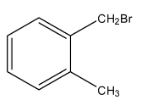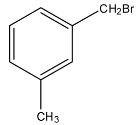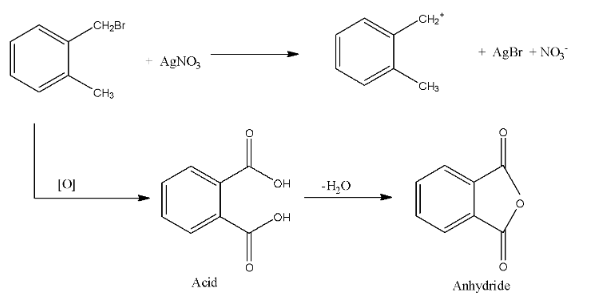
Compound (A), ${{C}_{8}}{{H}_{9}}Br$, gives a pale yellow color precipitate when warmed with alcoholic $AgN{{O}_{3}}$. Oxidation of (A) gives an acid (B), ${{C}_{8}}{{H}_{6}}{{O}_{4}}$. (B) easily forms anhydride on heating. Identify the compound (A).
a.

b.

c.

d.





Answer
513.6k+ views
Hint: In the question, the compound (A) can form a yellow precipitate with silver nitrate, this is due to the fact that there is the formation of silver bromide, this can be formed only when the bromine atom from the compound can be easily released, if the bromine atom is attached with the benzene ring then, it will not easily release.
Complete answer: In the question, the compound (A) can form a yellow precipitate with silver nitrate, this is due to the fact that there is the formation of silver bromide, this can be formed only when the bromine atom from the compound can be easily released, if the bromine atom is attached with the benzene ring then, it will not easily release.
So, from the given options, (a) is not correct.
The second part of the question says that oxidation forms acid and it can easily form the anhydride. An anhydride can be formed from the compound only if both the acid groups are very near. Therefore, from the given options, only option (c), can form the anhydride.
The reactions are given below:

So, from the reaction, we can see that a correct answer is an option (c).
Note: If the acids on the benzene ring are present on the meta and para positions then, the anhydride cannot be formed, and anhydride is formed when one molecule of water is removed from the acid.
Complete answer: In the question, the compound (A) can form a yellow precipitate with silver nitrate, this is due to the fact that there is the formation of silver bromide, this can be formed only when the bromine atom from the compound can be easily released, if the bromine atom is attached with the benzene ring then, it will not easily release.
So, from the given options, (a) is not correct.
The second part of the question says that oxidation forms acid and it can easily form the anhydride. An anhydride can be formed from the compound only if both the acid groups are very near. Therefore, from the given options, only option (c), can form the anhydride.
The reactions are given below:

So, from the reaction, we can see that a correct answer is an option (c).
Note: If the acids on the benzene ring are present on the meta and para positions then, the anhydride cannot be formed, and anhydride is formed when one molecule of water is removed from the acid.
Recently Updated Pages
Basicity of sulphurous acid and sulphuric acid are

Who Wrote James Pond? Novel vs. Video Game Facts

India's Latest UNESCO World Heritage City?

Who is the Tennis Player Known as 'King of Clay'?

Three beakers labelled as A B and C each containing 25 mL of water were taken A small amount of NaOH anhydrous CuSO4 and NaCl were added to the beakers A B and C respectively It was observed that there was an increase in the temperature of the solutions contained in beakers A and B whereas in case of beaker C the temperature of the solution falls Which one of the following statements isarecorrect i In beakers A and B exothermic process has occurred ii In beakers A and B endothermic process has occurred iii In beaker C exothermic process has occurred iv In beaker C endothermic process has occurred

Master Class 10 General Knowledge: Engaging Questions & Answers for Success

Trending doubts
What are the major means of transport Explain each class 12 social science CBSE

What is quantum energy class 12 physics CBSE

Which are the Top 10 Largest Countries of the World?

What is splicing class 12 biology CBSE

Why are dblock elements called Transition elements class 12 chemistry CBSE

What is a secondary cell class 12 chemistry CBSE




